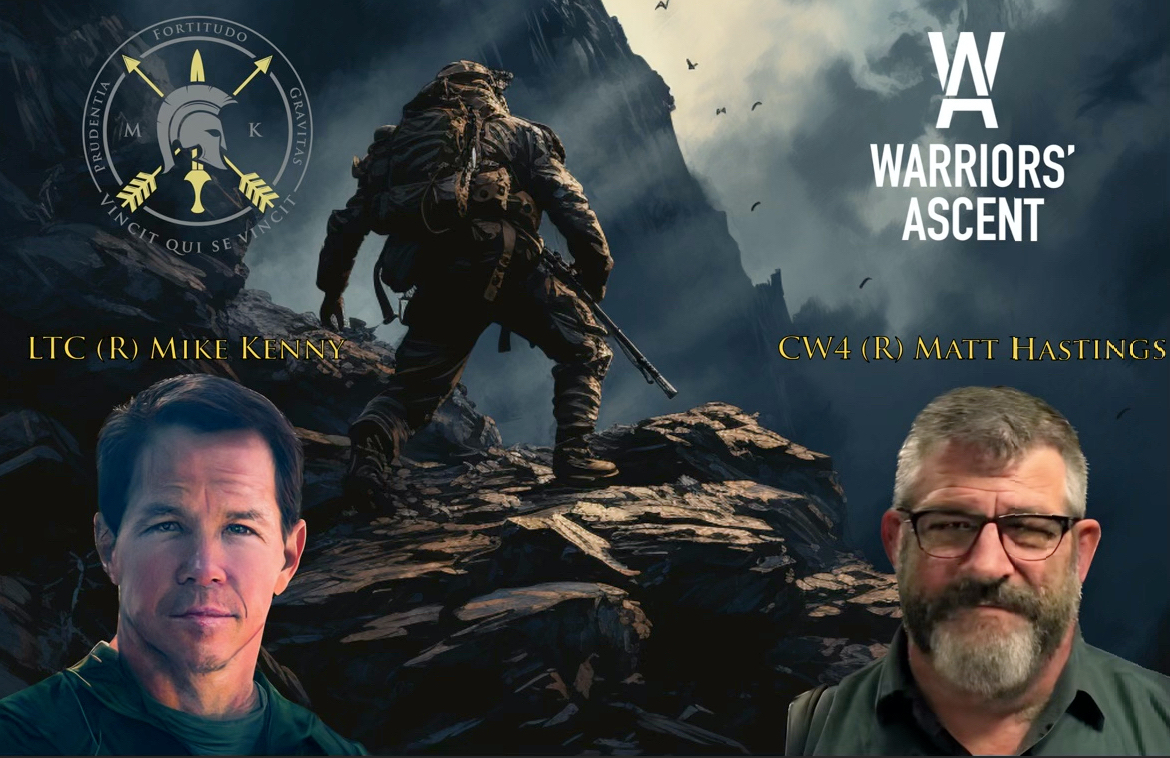The Warrior’s Ascent Podcast: From Healing to High-Performance
You are at war....with yourself, and likely don’t realize it. Your thoughts, beliefs, habits, and actions often sabotage you. Are they helping you overcome adversity or setting you up for failure? To win this battle you must connect with your inner Warrior. We all have a Warrior within us, one that strengthens our resolve and helps us rise to meet life’s challenges. If you’re just surviving rather than thriving, then it’s time to embrace the Warrior archetype, live the Warrior Ethos, and ascend. If you are a Veteran, First Responder, or someone looking to take charge of your life, find your tribe, and be the hero of your own story then this podcast is for you.
Join Mike Kenny and Matt Hastings, two retired US Army officers who served in US Army Special Forces and Aviation Units, as they share with you the optimal performance practices they learned in their time with the military and Warriors’ Ascent, a 501(c)(3) nonprofit organization that helps Veterans and First Responders dealing with post-traumatic stress. Best practices developed to fortify the mind, body, and soul to strengthen your resolve and conquer life’s challenges.
Vincit Qui Se Vincit
Episodes
Friday Apr 05, 2024
S3_E10_Christy Cook_Operations Director
Friday Apr 05, 2024
Friday Apr 05, 2024
Christy Cook
Operations Director
Join as we have a deep discussion with our amazing and dedicated Operations Director, Christy Cook. She brings passion and commitment to this organization due to her experience in the Non-Profit world and caring about others. Another thing that brings her experience to our gain is that she has been a military spouse for over 20 years supporting her Warrior, Jim through his dedicated service to our nation.
Friday Apr 05, 2024
S3_E10_Audio_Christy Cook
Friday Apr 05, 2024
Friday Apr 05, 2024
Christy Cook
Operations Director
Join as we have a deep discussion with our amazing and dedicated Operations Director, Christy Cook. She brings passion and commitment to this organization due to her experience in the Non-Profit world and caring about others. Another thing that brings her experience to our gain is that she has been a military spouse for over 20 years supporting her Warrior, Jim through his dedicated service to our nation.
Friday Mar 29, 2024
S3_E9_Audio_Tammy Brown Outreach Coordinator
Friday Mar 29, 2024
Friday Mar 29, 2024
Tammy Brown is well known and well respected by the alumni of Warriors' Ascent. She is our Outreach Coordinator and registers our Warriors for our course. She has the best empathy and generosity, she is kind and gets the job done like no other. Please meet Tammy Brown!
Friday Mar 29, 2024
S3_E9_Video_Tammy Brown Outreach Coordinator
Friday Mar 29, 2024
Friday Mar 29, 2024
Tammy Brown is well known to the alumni and those applying to attend a five day workshop with Warriors' Ascent. She is the voice, she has the compassion, and she can get the right people in the right spot when needed. She is a star on the team. Tammy Brown
Friday Mar 22, 2024
S3_E8_Video_Jeff Miner_Performance Anxiety
Friday Mar 22, 2024
Friday Mar 22, 2024
Jeff Miner
Triumph Performance Institute
www.triumphperformanceinstitute.com
Performance Anxiety
WHAT Skills:
- Observe
- Describe
- Participate
HOW Skills:
- One-Mindfully
- Non-Judgmentally
- Effectively
Friday Mar 22, 2024
S3_E8_Audio_ Jeff Miner_Performance Anxiety
Friday Mar 22, 2024
Friday Mar 22, 2024
Jeff Miner
Triumph Performance Institute
www.triumphperformanceinstitute.com
Performance Anxiety
Friday Mar 15, 2024
S3_E7_Video_Jeff Miner_Limiting Beliefs
Friday Mar 15, 2024
Friday Mar 15, 2024
Jeff Miner is our pro we call on to assist Veterans and First Responders on many topics. One of many is: Limiting beliefs: what they are, how they effect us, how we can overcome them, and sustain that into the future.
www.triumphperformanceinstitute.com
Friday Mar 15, 2024
S3_E7_Audio_Jeff Miner_Limiting Beliefs
Friday Mar 15, 2024
Friday Mar 15, 2024
Jeff Miner
Limiting Beliefs
www.triumphperformanceinstitute.com
Friday Mar 08, 2024
S3_E6_Audio_Anna_Savianno_Interpersonal_Effectiveness
Friday Mar 08, 2024
Friday Mar 08, 2024
Anna Savianno
Interpersonal Effectiveness
www.heartlandtherapyconnection.com
Friday Mar 08, 2024
S3_E6_Video_Anna_Savianno_Interpersonal_Effectiveness
Friday Mar 08, 2024
Friday Mar 08, 2024
Anna Savianno
Interpersonal Effectiveness
Acronym GIVE FAST - Be open minded :)
be Gentle
act Interested
Validation
Easy Manner
be Fair
no Apologies
Stick to your values
Tell the truth
Heartlandtherapyconnection.com

The Warrior's Ascent Podcast
What you can expect from this podcast: Accompany Mike and Matt, two retired US Army officers, on their lifelong Hero's Journey where they share the trials, tribulations, successes, failures, and valuable lessoned learned they've garnered throughout their Army careers and at Warriors' Ascent, a 501(c)(3) nonprofit organization that helps veterans and first responders with post-traumatic stress get on the path to healing in order to live joyous, fulfilling, and purposeful lives. Our goal is to provide actionable information through compelling stories, anecdotes, and cutting edge research that will empower the listener to take ownership of their life and thrive.






